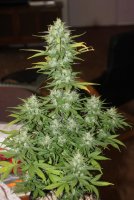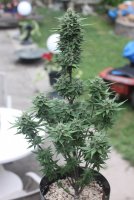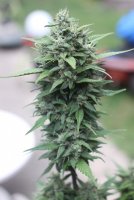- Thread starter
- #201
SQl2kGuy
Well-Known Member
August 02 2019 - Update
Images:
Bakerstreet #1 - Hanna Hemp - Looks healthy so far - growth nodes are exposed to light and air.
Bakerstreet #2 - Henna Hemp - Looks healthy so far - growth nodes are exposed to light and air.
C.R.E.A.M. #1 - Cowgirl Hemp - Looks healthy so far - budlets are exposed to light and air.
Cheese #1 - Gouda Hemp - Looks healthy so far - budlets are exposed to light and air.
Growth Stage:
2 Bakerstreets: Day 5/ Week 10 ... Day 68 ... week 2 flower.
*** Should get pixels between August 03, 2019 and August 10, 2019.
*** Photoperiod Stages: 5 days Germination, 1 week seedling, 2-8 weeks veg, 6-12 weeks flower, 4-12 weeks cure
*** Allow 1 day to 3 days of dark before switching to 12-12
*** Pistels show up about 14 days (2 weeks) after switching to 12-12
1 C.R.E.A.M.: Day 5/ Week 9 ... Day 61 ... mid flower.
1 Cheese: Day 5/ Week 9 ... Day 61 ... mid flower.
*** Should be ready for full flush between August 04, 2019 and August 11, 2019.
*** Should be ready to harvest between August 18, 2019 and August 25, 2019.
*** Autoflower Stages: 5 days Germination, 1 week seedling, 3 weeks veg, 3 weeks pre-flower, 3-6 weeks flower, 4-12 weeks cure
*** Pistels show up about 35 days (5 weeks) after Germination
*** Flowering takes about 42 days to 56 days (6 weeks to 8 weeks) after Pistels show up
Environment #1 - Autoflower Veg/Flower:
*** The VPD is now automatically dialed-in to High Transpiration: Mid Flower/Late Flower.
RH is running between 50% and 55% - lights-on.
Canopy temperature is running between 25°C (77°F) and 28°C (82°F) - lights-on.
VPD is between 1.23 and 1.30 - High Transpiration: Mid Flower/Late Flower - lights-on.
*** How The VPD For Environment # 1 Is Automatically Dialed-In
*** The VPD Values I am Using For This Grow (Version 1)
CO2 is refreshed frequently when the exhaust fan turns on.
The light is running 1 cycle of uninterrupted "24 hours lights-on and 0 hours lights-off".
The light is 53 cm (21") above the canopy centered over the 2 plants.
Environment #2 - Photoperiod Flower:
RH is running between 45% and 60% - lights-on.
RH is running between 60% and 60% - lights-off.
Canopy temperature is running between 26°C (79°F) and 28°C (82°F) - lights-on.
Canopy temperature is running between 23°C (73°F) and 23°C (73°F) - lights-off.
VPD is between 1.03 and 1.57 - High Transpiration: Mid Flower/Late Flower - lights-on.
VPD is between 0.80 and 0.80 - Healthy Transpiration: Late Veg/Early Flower - lights-off.
*** The VPD Values I am Using For This Grow (Version 1)
CO2 is refreshed frequently when the exhaust fan turns on.
The light is running 1 cycle of uninterrupted "12 hours lights-on and 12 hours lights-off".
The light is 53 cm (21") above the canopy centered over the 2 plants.
*** Once the photoperiods are harvested, then Environment #2 can become a Veg tent.
Watering and Feeding:
Bakerstreets:
*** Next feed ... 6 litres (1.6 gallons) - water only on August 05, 2019.
C.R.E.A.M.:
*** Next feed ... 4 litres (1.0 gallon) - water only on August 05, 2019.
Cheese's Feed:
*** Next feed ... 4 litres (1.0 gallon) - water only on August 05, 2019.
*** For details on my feeding schedule refer to here: The Different Feeds I need For This Grow (Version 4)
Activities:
LST on all plants.
I am checking the plants twice each day and adjusting the LST because the plants are growing quicker now.
My priority is to expose the growth nodes to light and air because they are going to become colas.
Refilled the humidifier with water.
Notes:
The priority has to be to expose the growth nodes/buds and to keep the canopy even and flat.
I will try to keep the Bakerstreets' canopy height below 30 cm (12"). For detailed calculations on how I determined the canopy height, please refer to the ... June 30, 2019 - Update ... Lessons Learned section here: How long to Veg Photoperiods
*** The VPD for Environment #1 is now automatically dialed-in.
*** I have ordered an Inkbird IBS-TH1 Wireless Thermometer Hygrometer to simplify collecting VPD data points for Environment #2.
*** I evened out the canopy on the C.R.E.A.M. today using LST wires.
*** How the VPD for Environment # 1 is automatically dialed-in:
The light is running 1 cycle of "24 hours lights-on and 0 hours lights-off" ... and is a constant heat source.
The light is 53 cm (21") above canopy centered over the plants.
The TaoTronics humidifier is set to 50% RH.
The Inkbird ITC-308 temperature controller is set to:
T: 25°C (77°F)
dC: 2°C (4°F)
When the temperature rises up to ... T + dC ... [25°C (77°F) + 2°C (4°F)] = 27°C (81°F) ... the exhaust fan turns on.
The CO2 is refreshed frequently when the exhaust fan turns on, ... expels the hot air and simultaneously draws in fresh air.
When the temperature drops back down to 25°C (77°F) ... the exhaust fan turns off.
This gives us the High Transpiration: Mid Flower/Late Flower VPD values we need for the C.R.E.A.M. and Cheese to flower.
*** The VPD Values I am Using For This Grow (Version 1)
*** Once the photoperiods are harvested, then Environment #2 can become a Veg tent.
Lessons Learned:
Complete Guide to Trimming Cannabis
By Nebula Haze
*** Continued from yesterday.
Here are some examples of buds from plants where I trimmed half the buds before, and half after. I wanted to help you see what difference it made. It’s really kind of different depending on each plant.
- The untrimmed buds took 0.5 to 3 days longer to dry. The leafier the plant, the longer it added to the dry time.
- The biggest difference is I noticed the “dry trim” buds seem noticeably more dense/uniform.
- The dry vs wet trim buds smell a bit differently, but all smell good. Neither seems particularly stronger or better as far as smell.
- I noticed that the “dry trim” buds often seem more brown as if they’ve been curing for months. The effect was most pronounced on the leafiest plants, which may have taken a little too long to dry.
- As far as comparing taste/smoothness/potency. In blind tests with cannabis enthusiasts, I’ve gotten mixed results. Some people prefer the smell or smoothness of the buds one way, while others like the exact opposite. It doesn’t seem to follow any particular pattern that I can tell. I truly think it’s a matter of personal preference, and also varies from strain to strain.
If sugar leaves are healthy and covered in trichomes, it’s more common for growers to leave them on.
This is what that might look like after the buds have been dried:
Sugar leaves are healthy and covered in trichomes.
Although these cannabis buds are beautiful and the sugar leaves are absolutely covered in trichomes (so you know they have significant amounts of THC), the buds may possibly be slightly more “harsh” than if all the sugar leaves had been trimmed away.
On the flip side, there are many people who prefer seeing trichome-encrusted sugar leaves on their buds, so in the end, it’s a matter of personal preference. There’s no right or wrong way about it!
How to trim your buds like a pro!
Sharp scissors (for trimming buds) – Fiskars shears are our weapon of choice. They are very sharp and have a pointy end, which makes it a lot easier to get your bud looking perfectly manicured!
Big pruning shears, or tough scissors you don’t mind destroying (for cutting off branches) .
These will be used to actually cut down single branches as you harvest colas to be trimmed.
If possible, try to use a separate pair, and not the same sharp scissors you plan to use for trimming buds. Some branches are tough enough to destroy a pair of nice scissors in a single harvest. You want sharp scissors for trimming your buds; it will save you so much time!
Disposable rubber gloves - Rubber gloves are actually meant to protect your hands from your bud! Handling bud without gloves will make your hands sticky to the point where it becomes a constant problem. Plus, hands covered in resin are difficult to clean!
3 Trays or Cookie Sheets - You need a tray to hold your untrimmed buds, one to hold your newly trimmed buds, and the last one to hold your ‘trim’ (the plant matter you cut off the buds).
Of course, you can use anything to keep your separate piles in, but cookie sheets have worked really well for me! Baking sheets work nicely and are cheap, but honestly, any non-absorbent flat surface will work. I like cookie sheets and other wide cooking pans because they have a lip around the edges to help keep everything contained!
Once you have all of your gear assembled, move onto the steps below when you feel ready. Keep in mind that this can be a lengthy process depending on how much bud you’ve grown. However, any negative feelings you get from the labor of trimming will be far outweighed by all the bud you’ll be drying soon!
One last thing… Don’t forget to save all your leaves and other trim! You can use the extra leaves you cut off to make edibles or hash. If you can see trichomes (“glitter”) on the leaves, that means they have good stuff to extract! If a bud is very small or wispy, sometimes I’ll throw that in the trim pile as well.
You can turn your trim into …
- Best Weed Butter Recipe
- Canna Caps
- Rick Simpson Oil (RSO)
- Dry Ice Hash
Before you start trimming your plants, you should set up a nice, comfortable place to trim your bud-laden branches. Trimming can take a lot longer than it might seem at first, and it’s a good idea to dedicate at least an afternoon to trimming. I usually try to start trimming in the morning on a day I have off with no other plans in case it goes on longer than expected.
As far as where to do your trimming, a large, clean and cleared table on a non-carpeted floor works great! You will be getting little pieces of leaves everywhere, even if you’re careful, so try to trim in a spot that’s easy to clean. If you have to trim on carpeting, put down a sheet or tarp so spare your poor carpet from trichome stickiness.
I like to get set up in front of a TV, so I can watch movies or shows in the background while I’m trimming. Music or radio can be nice too. In order to stay as comfortable as possible while trimming, I believe it’s important to make sure you get up at least once an hour, even if just to walk around the house or move to a different chair. Take a second to stretch your arms, shoulders and neck. Sometimes you can get in the zone while trimming and not move for a while, so making a point to make breaks will help keep your back, neck and hands from getting cramped up.
Put out your trays as you’ll be using them in just a moment. You’ll be using one tray to hold your untrimmed buds, one to hold your trimmed buds, and one to hold your leaves/trim. You want to keep it all separate if you can, though some spillover is inevitable.
Important Note: The trimming of buds creates a great deal of odor, especially if they’re fresh! The room that you trim in (and any adjoining rooms) will smell like a cannabis farm; it’s actually far worse than when they’re just flowering! Make sure to contain the smell and try to mitigate the odor if you can. I like to run an exhaust fan on a carbon scrubber (the same one I use in my tent) while I trim. While it doesn’t completely cancel out the smell, it does get pretty close.
Now that you’ve set up your space, it’s time to start harvesting!
2.) Wash your hands and put on a pair of gloves
I prefer latex gloves as they’re sturdy and it feels easier for me to change into a new pair. But any gloves you like will do the trick!
These gloves will soon be sticky with resin!
3.) Using your tough scissors, cut a branch off your cannabis plant
You may want to cut just one branch down the first time so you can get a feel for trimming, instead of cutting everything down at once. That way you can get an idea of how big of a branch you want to work with at a time.
If trimming immediately after harvest, this also allows you to harvest the plant in stages. If you have to stop halfway through for whatever reason, the buds will be fine for an extra day or two as long as they’re still attached to the plant (even if the rest of the plant is completely hacked up).
When cutting off branches to trim, remember to cut them to a comfortable working size.
No larger than these two or you’ll probably have a hard time handling them!
These are the leaves that are easily pulled off by their long stem. Put these fan leaves in a pile to be disposed of later.
Most fan leaves do not have a usable amount of trichomes on them. If you plan to save your trimmings to make hash you may want to put these bigger fan leaves in a separate pile so you can throw them directly away, instead of mixing them in with your trim pile. The big fan leaves add a lot of plant matter that you have to process, but without adding much THC.
5.) Trim Off the Sugar Leaves
Make a note of the small leaves that stick out of the buds; you will be able to see the leaf tips, but usually not the stems. These are typically referred to as “sugar leaves” and don’t need to be removed, only trimmed with your scissors if they stick out.
Trimming Sugar Leaves
If the sugar leaves are covered in a lot of trichomes, some growers will leave them on instead of trimming them. I personally don’t recommend doing that because any extra leaf matter tends to make buds harsher when you smoke them. You want as close to pure bud as possible. If you don’t want to waste all the trichomes on your sugar leaves, the best thing to do is save them in your separate trim pile and you’ll be able to extract the trichomes off the leaves later to make extracts like hash, caps or butter, This means you’re still getting all the THC, but without the added harshness of extra leaf matter. That’s why I highly recommend trimming all the sugar leaves until they are flush with the buds.
Sugar leaves are cut so they are flush with the bud, giving it a round, almost smooth appearance .
Do your best to make sure that all the ‘trim’ (the leaves trimmed from your bud) falls onto the tray designated for it. Not only does that let you save more trim for hash, it will help you with cleanup later! Try not to cut off any of the actual buds, but if you do by accident, feel free to throw it in the trim pile.
The whole trimming process can take a while depending on how much you ended up with, but if it’s more than you can do at once, it’s perfectly okay to harvest your plant in stages over a few days.
If the buds are already dried, you should put them in jars to prevent them from drying further even if they’re untrimmed. You could potentially come back to trim them later.
After trimming, your scissors (and fingers) will be covered in hash. Don’t throw that stuff away – it’s concentrated cannabis resin! You can vape, smoke or consume hash just like cannabis flowers!
Don’t toss out all your leaves! Learn how to turn your trim into…
Weed Butter
Canna Caps
Rick Simpson Oil (RSO)
Dry Ice Hash
6.) Dispose of your plant
If you haven’t yet, it’s time to securely dispose of the remainder of the plant!
Cut your plant up into pieces and double bag all the plant matter left over after harvest. Do not throw this bag away until the day your trash is picked up. This means there is less time where someone could go through your trash and find it!
ToDo:
Learn more about Complete Drying & Curing Marijuana Guide.
Learn more about pests and nutrient deficiencies.
Learn more about growing during flower and the stretching of colas.








